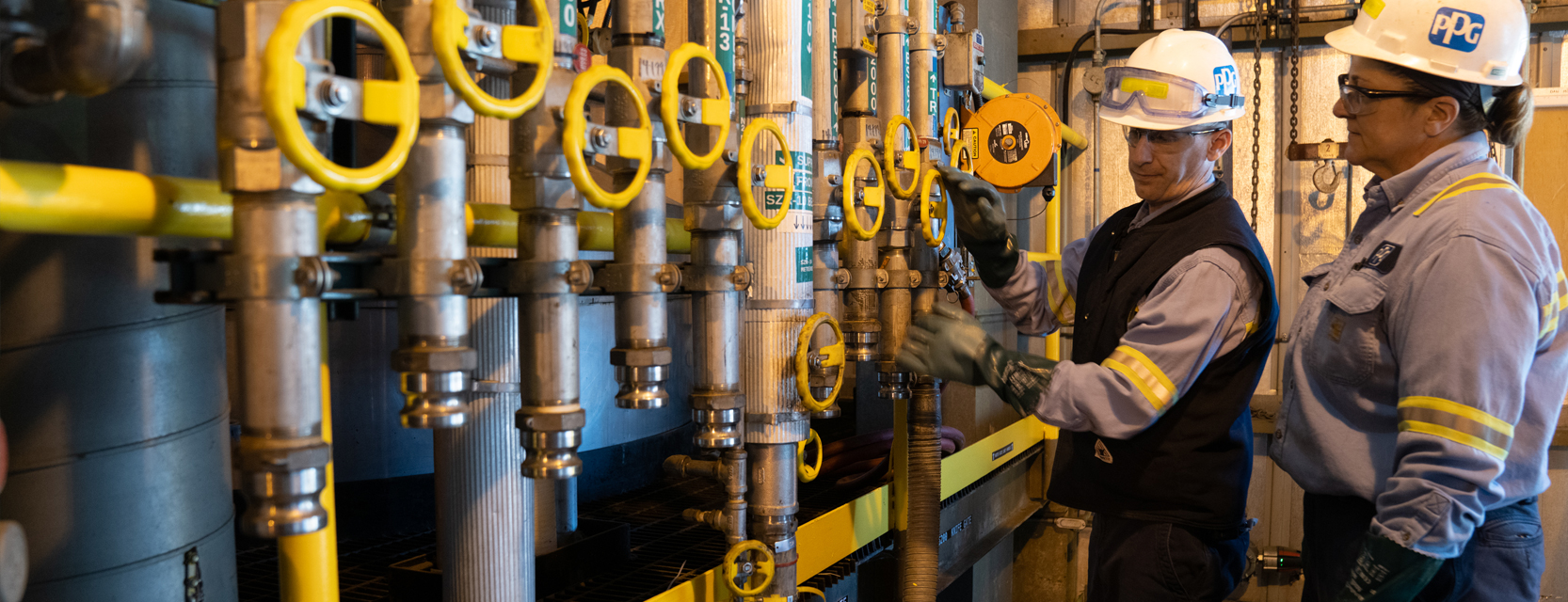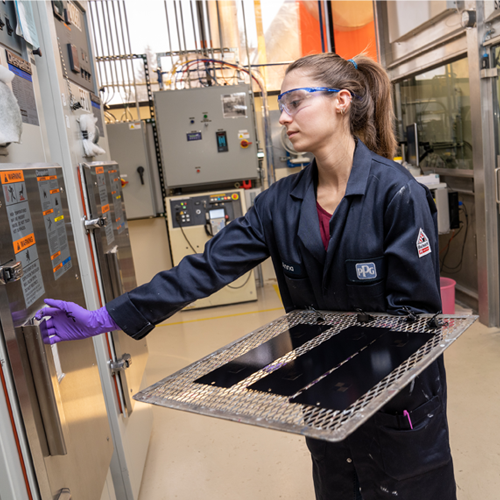ESG Report
Water

It is our responsibility to optimize water use through conservation and reuse
The majority of our operations have low water-use impacts and are not subject to restraints. However, we optimize our water use not only in water-stressed regions of the world but in all of our facilities through conservation and reuse.
 Our water management approach is based on a global mapping process that enables us to identify relative water withdrawal and discharge risks in our portfolio. Water consumption is closely managed and monitored at the site level and periodic reports that evaluate this progress are shared with executive leaders.
Our water management approach is based on a global mapping process that enables us to identify relative water withdrawal and discharge risks in our portfolio. Water consumption is closely managed and monitored at the site level and periodic reports that evaluate this progress are shared with executive leaders.
At many PPG sites, much of the water consumed is for equipment cleaning. In 2021, we continued to improve our processes to require less cleaning and water use while maintaining high-quality production standards. We also evaluated new opportunities to reuse wash water in our processes and products. For example, we scaled our efforts in support of our Zero Discharge Project, an effort within our Architectural Coatings business to reduce wastewater discharge from its most water-intensive facilities.
Managing Water Risks
Typically, our water withdrawal risks are associated with sites that have a higher water intensity and operate in water-stressed areas. At these locations, we engage with appropriate stakeholders, such as the local water authority, to assure that we have an adequate water supply for our manufacturing process and respect the needs of the community.
We use the World Resources Institute's Aqueduct Water Risk Atlas to evaluate the water risks at our locations globally. Overall water risk includes water stress, variability from season to season, pollution and water access.
Specific water risks we evaluate include:
- Availability of clean water resources;
- Local water restraints, especially in water-stressed regions;
- Water quality; and
- Regulatory and financial impacts, including constraints from local communities, other water users, the ability to obtain water rights and permits, and regulatory restrictions.
We rank our sites based on water usage, scarcity risk and other factors, and we update the ranking each year to reflect operational changes and sites that are acquired or sold.
To address our water risks, we ensure water consumption is monitored at all plants – not just those considered higher risk – by including the metric in each plant's environmental scorecard. This increases visibility into our water use at the local, regional and global level and encourages our employees to remain engaged and committed to conserving this valuable resource.
Our operations withdraw water from varying sources depending upon availability in the areas in which they are located. These sources include municipal water, surface water and groundwater.
As noted, much of the water we consume is for equipment cleaning, with some used for equipment cooling and as an ingredient in production. We are looking across our product formulations and entire production process to find opportunities to reduce water consumption and water discharge. For example, in our plant in Valencia, Spain, a waterbased waste evaporator has been installed to recover water from waste. Recovered water is re-used in the plant cooling tower.
As part of our commitment to environmental stewardship, we set a global goal of a 20% reduction in water intensity by 2025 from a 2017 baseline. More stringent goals can be set at individual sites, depending on water usage and availability.
In 2021, our water intensity was 4.4 cubic meters per metric ton of production, which was 5.3% lower than the baseline. Globally, we withdrew 16.9 million cubic meters of water during the year, which was a 12.3% reduction compared to the baseline. Although water intensity decreased in 2020 as a result of the pandemic and hurricanes impacting our Lake Charles facility, as we expected, once production returned to normal at Lake Charles in 2021, so did the water intensity. However, overall water intensity remained below 2019 levels. We remain optimistic that our water goal will still be achieved by focusing our water efficiency efforts on the limited number of sites that use the majority of our water.
Zero Discharge Project
PPG's Zero Discharge Project is an initiative intended to reduce waste intensity and increase wash water reuse at our Architectural Coatings facilities in the U.S. and Canada. By saving the water used to wash the tank and piping after a batch of paint is made, sites are able to use the recycled water in the production of future paint batches, without disruption to the end product's performance. The wash water recycling also lowers the cost of paint production by requiring less virgin raw materials and reducing treatment and disposal costs.
Over the last two years, the project has delivered more than $2 million in savings while reusing more than 1.7 million gallons of wash water. Additional sites across our network are exploring implementation of the program as well.
We discharge the majority of our wastewater to municipal treatment facilities in compliance with all local regulations, and we monitor and report water quality as needed. In some cases, we are required to treat discharged water prior to release.
We ensure each location complies with all of our internal water discharge management guidelines, which include:
- All water discharge sources are identified, characterized and documented according to regulatory requirements;
- Regulatory requirements for water discharge are identified and documented;
- The facility demonstrates compliance with all regulatory requirements;
- The facility identifies and documents operational control procedures and maintains a written preventive maintenance program for all critical water management equipment;
- Personnel are trained in accordance with regulatory requirements and facility compliance; and
- Documentation and records pertaining to the water discharge management program are maintained according to regulatory requirements.
Some of our operations are located near waterways, such as rivers or streams. To address and mitigate pollution risk, we focus on spill elimination and spill control and response.
Reducing wastewater from equipment cleaning
In some of our plants, scrubbers act as an air emission control device. Contaminated water is continuously removed and replaced with fresh water and then disposed of as a nonhazardous waste.
At our facility in Euclid, Ohio, water blow down from the scrubber was reduced while operation of the scrubber was monitored to understand any potential performance issues. Water blow down was reduced from 3.1 gallons per minute to 1.5 gallons per minute with no impact to performance of the scrubber. This reduction has in turn decreased the volume of wastewater by 228,000 gallons per year, while also reducing cost.
Swapping bearings to conserve water in silica manufacturing
More than 80 years ago, PPG was one of the first manufacturers to pioneer the development of synthetic precipitated silica. Today, these products are used by major manufacturers around the world for a variety of applications, from anti-corrosion additives for paints to reinforcing fillers for tires.
In the manufacturing process, silica precipitate is filtered, washed and dried. The traditional drying process can be waterintensive, depending on the drying equipment and process.
At our Lake Charles site in Louisiana, older water-cooled bearings used in the assembly of rotary dryers in the silica manufacturing process were replaced with newer technologies that use sealed-style bearings. Moving to these style bearings not only conserves water but also provides a cleaner and safer walking and working surface around these pieces of equipment.
By switching to the sealed bearings, the site expects to save 40 million gallons of well water each year.
Water IntensityCubic meters per metric ton of production |
|||
|---|---|---|---|
|
2017 |
4.62 |
||
|
2018 |
4.35 |
||
|
2019 |
4.50 |
||
|
2020 |
3.94 |
||
|
2021 |
4.37 |
||
Data changes from prior reporting reflect adjustments for acquired and divested locations from the 2017 baseline onward.
Water Consumption – All SourcesMillion cubic meters |
|||
|---|---|---|---|
| Withdrawn | Discharged |
Net Consumption |
|
|
2017 |
19.30 |
8.20 |
11.10 |
|
2018 |
18.34 |
8.69 |
9.65 |
|
2019 |
17.94 |
7.95 |
9.99 |
|
2020 |
14.50 |
7.37 |
7.13 |
|
2021 |
16.92 |
8.45 |
8.48 |
Water withdrawal and water discharge data are provided by each location on a monthly basis using the best available data, including direct measurements when possible. Data changes from prior reporting reflect adjustments for acquired and divested locations from the 2017 baseline onward.
2021 Water Withdrawn – All Sources |
|
|---|---|
| Source |
Amount Withdrawn |
|
Surface water |
4.68 |
|
Groundwater |
6.72 |
|
Seawater |
0 |
|
Produced water |
0 |
|
Third-party water |
5.52 |
2021 Freshwater Consumption |
|
|---|---|
| Source |
Amount |
|
Municipal water withdrawn |
5.52 |
|
Fresh surface water withdrawn |
4.68 |
|
Fresh groundwater withdrawn |
6.72 |
|
Water discharged |
8.45 |
|
Net freshwater consumption |
8.48 |
Water Usage in Water-stressed Regions |
|||
|---|---|---|---|
| Percent of Total Withdrawn | Percent of Total Consumed | ||
|
2017 |
8.0 |
8.4 |
|
|
2018 |
9.0 |
10.6 |
|
|
2019 |
9.5 |
10.0 |
|
| 2020 |
11.4 |
15.1 |
|
| 2021 |
10.2 |
11.7 |
|
Included facilities are in North America, South America, Europe, Australia and Asia. Data changes from prior reporting reflect adjustments for acquired and divested locations from the 2017 baseline onward and updated water-stress analysis.
Water Non-Compliances |
|||
|---|---|---|---|
| Number | |||
|
2017 |
5 | ||
|
2018 |
3 | ||
|
2019 |
6 | ||
|
2020 |
7 | ||
|
2021 |
6 | ||
Data cover non-compliances associated with water quality permits, standards and regulations and is based on the year that PPG is notified of the non-compliance by a governmental authority.
Water non-compliances are typically minor deviations from existing discharge permits. These incidents are thoroughly investigated and corrective actions are implemented to minimize reoccurrence.

